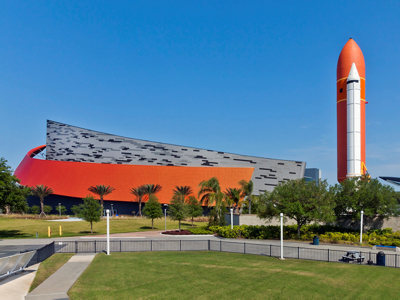 By Jeff Alexander, Valspar Corporation
By Jeff Alexander, Valspar Corporation
When looking at architecture from around the world, it’s evident that designers can achieve nearly any look with the multitude of building products available on the market. However, one material stands alone due to its aesthetic and practical versatility, durability and sustainability – metal.
Today, architects are choosing to work with metal as it offers building owners an option that can meet a wide range of budgets, designs and environmental agendas. From wall paneling to roofs, curtain wall fins and mullions to soffit systems, metal has become a standard within the industry for a product sturdy enough to withstand mother nature’s harshest tests, yet aesthetically pleasing to the toughest critic.
| |  |
| | Shown above, the Space Shuttle Atlantis Exhibit Enclosure. See more of this project here and here. |
Canvas for Creativity
Picture this: you’re an architect that’s been tasked with designing a building that will house the iconic Space Shuttle Atlantis. When drawing up plans for the 90,000 square-foot exhibit, it’s imperative that the exterior is as remarkable as the prized shuttle within. Therefore, a building was designed to pay homage to the shuttle’s launch and return, complete with its very own orbital ring. After assessing product needs, it was evident that the only pliable material to create the giant orbital ring, as it had to be versatile enough to bend and contort in the ways required, was metal.
The malleability of metal increases its visual appeal. With options to be installed horizontally or vertically, bent into s-curves or applied smooth, metal wall and roof paneling can help builders achieve a desired look without having to factor in costly support systems for otherwise dense material.
Metal also provides a canvas for creativity. Working alongside architectural metal manufactures are coatings providers, who discover unique ways the materials can be paired to achieve a desired look. Architectural coatings not only add a level of durability, but influence the look of a building as well. Even the most popular coating choices, Gray, Silver and White, can be treated with unique finishes such as prints, embossed, stamped or textured looks to give the appearance of wood shake, slate or tile. Furthermore, coating manufacturers have created formulas that can give metal paneling the appearance of shifting color in the sun, making aesthetic options nearly endless.
A coated panel exponentially increases the design options available on the market, and with most coatings compatible with various substrates including aluminum and steel, we’re seeing metal being used more often across both commercial and residential markets.
Strength in Metal
Key to any architectural project is the reassurance that the money spent, will result in a favorable building life expectancy. The building materials selected, in addition to the maintenance and upkeep required, are part of the puzzle that make up the lifespan of a building.
Utilizing metal on a building’s siding and roofing offers advanced durability and often results in fewer repairs over time, which saves time and money on maintenance routines. Furthermore, it is a lighter weight material than alternative roofing options, putting less stress on standing structures.
Enhancing the durability of a metal panel and energy efficiency of a building, architectural coatings offer building owners a product to protect the exterior of a structure that also saves on the bottom line. Coating manufactures continue to develop formulations to resist etching, marring, and erosion rates to keep buildings looking new. Coated metal paneling can also protect a building against the effects of weather conditions, specifically offering a waterproof barrier that stands up to humidity, acid rain and corrosive salt.
 | |
Shown above, the Humane Society of Silocon Valley Animal Community Center. See more of this project here and here. | |
Shielding the Environment
Beyond the aesthetic and durability benefits that building with metal offers, the environmentally friendly and sustainability properties allow architects and construction teams alike to feel confident in the materials they are choosing.
With programs like LEED®, ENERGY STAR®and Living Building Challenge that were created to award those with environmentally friendly agendas, finding and using sustainable products has become a necessity. For example, the Humane Society of Silicon Valley (HSSV) recently set out to build a new Animal Community Center. In addition to creating a space for the animals to flourish, HSSV sought to meet the stringent sustainable agenda that would make it the first LEED Gold Certified animal community center in the country. To accomplish this green credential, HSSV planned its facility carefully, with upfront investments in smart design and materials. One of those materials was metal. The exterior of the building is comprised of nearly 1,000 square-feet of metal panels coated in a colorful palette of 70 percent PVDF coatings. In addition to providing added durability, the reflectivity of the coatings contributes to the building’s efficiency. Thanks to their role in reducing solar heating and lowering cooling costs, the coated metal helped HSSV achieve the LEED Gold Certified accreditation they were seeking.
Metal is a 100 percent recyclable product at the end of its life, lending to its environmentally friendly use. Furthermore, as most metal panels on the exterior of buildings are covered with a protecting paint, manufactures of architectural coatings are evolving the chemistry to provide options that reduce or eliminate hazardous materials and contain solar-reflective pigments. As manufactures increase transparency around coating formulations, it makes it easier for users to meet the stringent demands of sustainability programs like LEED v4 and Living Building Challenge’s Declare Programs.
Metal panels also excel when looking at the energy efficiency of a building. Constructing with coated metal panels helps building owners realize cost savings on energy bills as they are designed to protect against extreme weather conditions – high heat, bitter cold—by maintaining a consistent temperature.
Perhaps the most energy efficient use of metal is its incorporation into a roofing system. The metal itself reflects solar energy from the surface, however, when finished with specific coatings, solar energy is re-emitted. Solar reflective coatings are formulated using pigments that reflect infrared radiation. Building owners who utilize SR coatings can see a potential savings of $20 to $30 per year per 1,000 square-feet of roof space.
Keeping all benefits in mind, building with metal and even more specially, a coated metal, is a versatile and environmentally conscious construction practice. Metal building products help property owners and architects meet the driving desire to achieve high sustainability marks, while offering a solution that doesn’t sacrifice on aesthetic or durability.